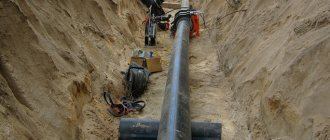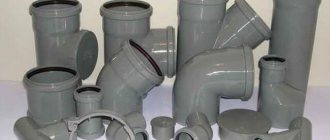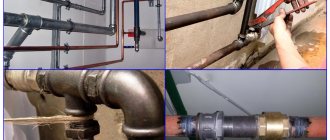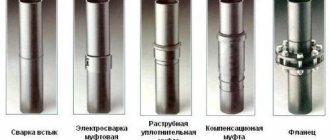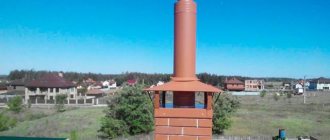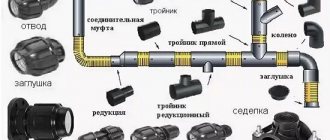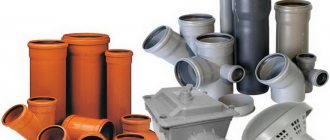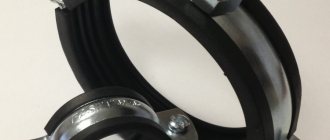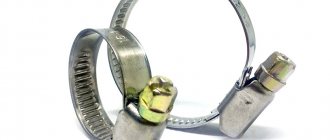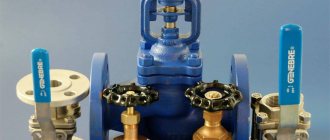Pipes are classified according to a large number of characteristics, the main ones are listed below:
- Material from which they are made: metal;
- reinforced concrete;
- polymer.
- suture;
- round;
- for high pressure;
This simplified diagram minimally shows the large family of this product as well as its wide range of applications.
The main task of joining pipes is to obtain a seam that is tight, durable, and reliable. They are divided into two types: detachable and one-piece:
- Detachable connections: threaded;
- flanged;
- bell-shaped
- welding;
Depending on the operating conditions, material, and geometric dimensions, the best connection method is determined.
Thread
Threaded connections are among the most ancient. They are used only on round pipes. Based on the direction of torsion, a distinction is made between right-handed and left-handed threads. The second is rarely used, only in special cases.
This type of joint is suitable for water, gas, and oil products.
The ends themselves are twisted using additional fitting coupling parts.
Couplings are standard with internal threads on both sides. There are also combined ones, internal on one side and external on the other.
Threaded connection of steel pipes
Detailed description of each method
Threaded
They can be done in several ways, the most common being squeezing.
The following tools will help you do this job:
- Pipe wrench.
- Coupling with internal thread.
- Seals for sealing. Maybe: hemp rope, FUM tape or sealant.
- Lock-nut.
Two pipes have external threads . We apply sealant to them. One has a longer thread length than the other. Where there are more turns the nut is screwed on until the end. Then the clutch. Then we screw it onto the second part, twisting it with the first one. When the coupling stops screwing, we support it with a locknut. Tighten with wrenches, carefully, so that the coupling does not burst.
Flanges
For a flange joint you will need:
- two flanges;
- paronite gasket;
- bolts, washers, nuts;
- keys;
- manual arc welding;
- level.
The flanges need to be welded. Avoid displacement; they must be in the same plane.
We catch using a horizontal level. We screw two bolts into the upper holes. We put the part on the edge of the tube so that the bolts are at the top. We put a level on them and catch the position of the bubble between the strips in the middle. When caught, we make a tack by welding at the top point. The horizontal plane is ready.
We rearrange the level to a vertical position, leaning it against the flange mirror. We catch the level by slightly adjusting the lower end of the flange that is not yet stuck. Having established the vertical, we installed the second tack. And then two more, resulting in four even sections.
Then the welder welds the flange on both sides. Manipulations are carried out similarly with the second pipe.
After welding, we get two pipes that can be connected. We insert four bolts into the holes from below and tighten them a little. We make a gap, insert a gasket. We insert four more bolts and tighten everything.
Bonding
This method is used very rarely in metal parts. The process itself does not require any special skill from a person, but it takes a lot of time.
This job requires:
- glue. BF-2 or 88N or EDP;
- brush.
Before gluing the parts, first apply the first layer on their surface and allow to dry. This layer will be the bonding layer. Each glue has a drying time written in its instructions. Then a second layer is applied and the parts are placed under the press for a day or even more. It all depends on the glue.
Then clean the seam from any glue leaks.
Crimp connectors for steel pipes
Welding
The welding process is used in almost all metal pipe joints.
In order to obtain a seam, the following welding methods are used:
- gas;
- electric arc;
- contact
Gas welding is used to obtain permanent connections in small diameter pipes with minimal thickness.
When welded in this way, it can also conduct water. The main thing is to test the seams for leaks after welding.
The gas welding station consists of:
- oxygen cylinder;
- acetylene;
- rubber hoses;
- burners.
Resistance welding is rarely used. This method has proven itself more effective in working with plastic pipes.
The most popular method of producing permanent joints is electric arc welding, divided into:
- manual
- semi-automatic in protective gas environment
When constructing pipelines, connections are made only by welding. An important part is preparing the joint for welding.
The pipe must be connected to another:
- no fractures or displacements;
- the joint must be cleaned;
- make a chamfer;
- set the gap to 1-3 mm.
Required welding equipment:
- electrodes;
- power source (transformer or rectifier);
- cable;
- Personal protective equipment for welders: overalls, mittens, brushes.
Soldering of polyethylene pipes end-to-end and using an electrofusion coupling
Trumpet
This type of connection is widely used in cast iron pipes for the oil and gas industry, housing and communal services. One of the simplest options for permanent joints.
The main process of obtaining a joint is to seal the gap between the socket and the surface of the conical pipe. Cement material is used for this.
First, a response pipe is inserted into the socket and then sealed with caulk, an airtight material. After the cement solution is diluted, the gap is tightly stamped with it.
To seal the socket, grade 300-400 cement is used, which is thoroughly mixed with water in a ratio of nine parts cement to one part water. The socket is filled with cement mortar using a scoop and embossed until the latter begins to bounce off the cement.
Pressing
This method of obtaining a permanent weld has become necessary for small-diameter connections made of non-ferrous metals. Conventional electric arc welding is not capable of welding such metals due to its technical parameters, so in this case they found a different approach.
In order to weld, you need to insert the prepared end into the fitting until it stops. Then treat its surface with a manual or hydraulic press.
To join such thin-walled non-ferrous metal pipes, press fittings with crimp sleeves are used. They perform crimping on the inside of the pipe, and external seals ensure the joint is sealed.
Threaded connection
This type of connection is perhaps the most suitable for installing a home heating system, since you can independently assemble and disassemble any system assembled using this method.
You can buy ready-made pipes with threads, threaded couplings, angles, but you can cut threads on them yourself; the procedure is not complicated, but it requires some effort:
- You need a set of dies (dies), a die holder for cutting external threads.
- We insert the die with the diameter you need into the die.
- the pipe on which threads are needed using a grinder.
- We clamp the part in a vice.
- We chamfer it, that is, we make the outer edge a little rounded so that the die fits better.
- You can lubricate the thread cutting area with machine oil.
- clockwise . This must be done carefully, since a slight misalignment determines how the couplings and angles will be screwed onto a given thread.
- If, after making 2-3 turns , the lever does not want to move, turn it back half a turn and, with a little effort, start moving again.
- After the threads are screwed, remove any remaining oil and metal filings.
- Try screwing the coupling onto the thread.
If you know someone who has an electric drive, this will make the task much easier. And the whole thread cutting process will take a few minutes.
taps
Now let's look at the process of cutting internal threads:
- A set of taps and wrenches is required
- We select taps (rough, medium, finishing) of the required diameter.
- the rough tap in the driver, clamp the pipe in a vice and slowly begin, like a drill, to cut the internal thread.
- If the tap does not move , it is clogged with chips, unscrew it and start again.
- We do the same with the average and fine dreamers.
As for the joining process itself, you will need a sealant (flax, fum tape, sealing thread) and sliding gas keys. A sealant is wound onto the thread, along the thread, we try to ensure that the sealant does not get inside the pipe.
If flax is used, then it is necessary to stretch the linen thread, wind it and lubricate it, for example, with red lead for better compaction. We screw a coupling, angle or other pipe onto the pipe.
If the pipes cannot be twisted
In this case, a coupling, a drive and a lock nut are used:
- onto the squeegee .
- onto the long thread until it stops.
- The short end with the seal is screwed into another coupling, valve, or fitting.
- The coupling , when unscrewed, is screwed onto another thread and tightened with a lock nut
Advantages and disadvantages of each method
Thread
Advantages:
- reliability;
- ease of assembly, possibility of disassembly;
- low cost.
Flaws:
- tension in the thread cavities increases material fatigue, reducing its strength;
- the need to use locking means to prevent the working element from unscrewing.
Flanges
Advantages:
simplicity and convenience of reusable connection and disconnection.
Negative properties:
- high labor intensity in manufacturing, therefore, high price;
- with prolonged use, the location of its connection decreases, loss of tightness.
Bonding
The advantages of this method include its not labor-intensive process, which does not require much skill and effort.
But the wait for gluing sometimes reaches three days, which is not always convenient.
This type of connection cannot be considered a reliable method.
Welding
Advantages:
- reliability;
- durability;
- tightness;
- the ability to connect parts of any shape.
Flaws:
- the occurrence of residual stresses;
- possibility of changing geometry;
- risk of destruction under vibration and shock loads.
Trumpet
In comparison with all types, socket pipes have the advantage of low cost, the possibility of small axial and lateral movements of the pipe, which is very useful during temperature changes and soil shrinkage.
The negative indicator lies in the difficulty of connecting the connector and insufficient reliability at high pressure.
Pressing
A common positive factor is excellent self-centering of the joined parts and stable state under shock loads. A simple and non-labor-intensive process.
Cannot be disassembled or dislodged from each other. Here are a few disadvantages of this method.
Methods for connecting metal pipes
Comparative characteristics of various pipes
Metal pipes
Separately, it is worth noting those cases when copper is used in the pipeline, which is quite exotic. The fact is that copper is too soft and ductile to be used for installing plumbing fixtures. The only option may be to install a copper elevator assembly made of copper with the rest of the wiring made of polypropylene pipes
Therefore, in the future we will not take copper products into account.
As is known, the main qualities that determine the high demand for metal products are their resistance to mechanical damage and hardness.
In addition, each type of metal pipes has its own individual characteristics:
- steel products are subject to overgrowth of the internal surface and corrosion;
- zinc-coated pipes are resistant to corrosion, however, they are quite difficult to install;
- stainless steel – such pipe products are highly expensive and quite difficult to process;
- cast iron pipes - earlier brands were quite fragile to impacts, but ductile iron cast iron is quite strong (more details: “Characteristics of ductile iron pipes, features of production and use”).
Pipes made of polymer materials
In this case, it is worth dividing plastic pipes into products made of polyvinyl chloride, polypropylene and polyethylene.
The characteristics of each type of product are as follows:
- polyvinyl chloride is a fairly fragile material, so it is used for sewer pipes, although not often enough;
- polyethylene – has a low melting point (starting from 80 ℃), a fairly plastic and soft material, so it is advisable to use them only for cold water supply;
- polypropylene is the most durable material; compared to other polymers, it is much lighter than others, so it can be successfully used for hot water supply pipelines.
Methods for connecting metal pipes to plastic
Areas of use:
- repair, replacement of old pipeline;
- construction, when installing a gas pipeline, plastic pipes are used, but in a residential area, gas should only be in metal pipes.
In such cases, several connection options are used:
- Welding-threaded. In this case, combined couplings are used. Here one side has a thread, the other a coupling. The thread connects to the metal end. The other side has a plastic end. Such adapters are used for small diameters.
- Flanged. For larger diameters, flanges are used. In some cases, metal hoses are used.
Methods for joining polypropylene pipes
If the task is to equip heating with small-diameter plastic pipes (up to 63 mm), in practice there are two ways to connect such pipes:
- socket welding - in this case, one pre-expanded end of the pipe is placed into the other;
- sleeve welding - here the ends of two elements are connected to each other using a sleeve.
In the case of joining pipes with a large diameter (from 63 mm), they resort to butt welding. This installation method does not require additional connecting elements, maintaining an excellent degree of pipe fixation. You can also use fittings of suitable size (socket welding). If there are pipes with a diameter of 40 mm, it is more convenient to use manual welding, but larger elements are usually joined using a special apparatus that pre-aligns them.
Immediately before starting installation of the heating system, it is worth once again carefully considering the entire process of assembling the pipeline. This will allow you to avoid unwanted nuances during operation that affect the final quality of the heating system assembly.
Scheme of the process of connecting polypropylene pipes
Here we will outline the main nuances of how to connect plastic heating pipes:
- The optimal heating time for a soldering iron is 5 seconds.
- The recommended melting temperature of polypropylene is 270°C. This parameter can be achieved using a special toggle switch installed on the welding machine.
- It should be noted that the technology for joining heating system pipes will vary depending on the location and time of year. So, during periods of sub-zero temperatures or when installing a heating structure outdoors, the heating time of the soldering iron pipe should be slightly increased or the temperature raised for melting polypropylene products.
- In the case of joining pipes of larger diameter, the melting time of the material will also increase slightly.
- The recommended time for fixing large-diameter elements to each other after heating is 30 seconds or more.
Next, it is necessary to consider in detail the technology of soldering polypropylene pipes:
- After reaching the required temperature, the connecting parts (coupling, pipe) are simultaneously put on the soldering iron nozzles for polypropylene pipes - for the external and internal dimensions of the cross-section of the pipes - and heated up.
- During the heating process, “flanges” are formed on the heating elements.
- As a result of the heating process, both parts are removed from the nozzles and docked with each other by uniformly gently pressing them on both sides towards each other and fixing them in this position. Any rotations or unnecessary movements when joining elements are unacceptable, as this may damage the resulting seam.
- The connected elements should be held for 30 seconds to ensure more reliable adhesion of the heating system parts. It must be added that the side must be even along the entire length of the connection.
After complete cooling, the connected parts are ready for use.
Welding process parameters
Tips and tricks
- When working with cast iron pipes, you must remember that they are fragile. For embossing and pressing, use rubber hammers.
- If the installation of a socket joint is carried out outdoors in hot weather , then when the cement is in the gap, it is suggested to lay a damp cloth on it. So that the cement does not crack.
- When gas welding, the flammable gas acetylene is used. If desired, it can be replaced with propane, which is cheaper and safer.
- When constructing a water or gas supply pipe system, try to weld the rotary joints first, and then, when the entire structure is assembled, weld the fixed joint last.
- When tightening the bolts on the flanges, do not overtighten. It is possible to strip the thread, this also applies to threaded connections.
Installation of steel pipes
Steel pipes can be joined together using the following methods:
- threaded;
- welding;
- coupling;
- flanged.
Threaded connection
In this case, it is recommended to use threaded connections of heating pipes in those places of the heating pipeline where it is possible to check the reliability of the joining of pipes to facilitate further repairs of the heating system. In most cases, pipe carving is done using special tools, although the manual method also occurs here.
In order to carry out this procedure, it is initially necessary to remove the outermost part of the pipe, providing the necessary length allowance for the thread. Then use a die to cut the threaded connection. The operation is carried out using a tool fixed on a die holder.
Thread cutting
Working with the above device looks something like this:
- The pipe is secured in a vice to prevent twisting.
- The die is carefully placed on the tip of the pipe. In this case, you should be extremely careful to avoid distortion in the connection.
It is also worth listing some recommendations here:
- To make work easier, the surface of the pipe is treated with automotive oil.
- If there is a need to cut threads on a section of pipe located close to the wall, then in this case you will have to resort to die holders with a ratcheting mechanism, which will allow you to completely rotate the tool along its axis.
- In the case of sealing the connections of individual elements of the heating system, a special winding is used for plumbing-type heating pipes.
- Before tightening the threaded connection, you should check the mating ends for stuck chips and burrs.
Rewinding steel pipe threads
If the die jams, you need to make half a turn with the tool back, which will allow you to remove the chips stuck in it.
Welding connection of heating pipes made of steel
When installing a pipeline, steel pipes are most often joined using an electric welding machine. In this case, the named process involves the presence of metal electrodes, which serve as conductors and act as an “additive” that connects the weld.
In order to obtain a welding joint of proper quality using electric welding, it is enough to adhere to some conditions, which we list below:
- Before the welding process itself, it is imperative to clean all parts of the pipeline from dirt, debris and sand.
- If necessary, try to return the deformed ends of the elements to their original position or evenly trim the ends of the pipes.
- In the case of arc welding, the outer and inner surfaces of the pipe at the joints should be cleaned to a width of 10 mm.
- Each completed layer should be cleared of slag formations before applying the next one.
In most cases, the primary welding layer is created by stepwise surfacing. Next come the solid layers. When joining heating elements, a breakdown into sections of stepwise surfacing is done, followed by connection through one of the resulting sections. After - the remaining places of the pipe.
The process of forming a welded joint
The application of the primary welding layer requires special attention. In this case, each edge here must be completely melted. If a defect is discovered, it is recommended to repeat the operation, first cutting out the damaged area.
To apply subsequent welds to the primary welding layer, the pipe should be rotated evenly and slowly. It is recommended to start the second and third layers, each time moving approximately 15-30 mm from the previous one. The last seam should be smooth and smoothly transition into the outer base of the heating element.
It should be added that the thickness of the pipe determines the size of the welded layers. Thus, for welding elements with a cross-sectional size of up to 6 mm, two layers are used. For a pipe measuring 6-12 mm - three layers. For elements from 12 mm, four layers of welding are required.
Welding of heating elements must be carried out at a continuous pace.
Connection using a coupling
A tight and reliable connection of steel pipes using the coupling method is carried out during the installation of pressure and non-pressure pipelines. The individual elements are connected to each other as follows:
- in the places where the coupling will be fixed, marks are first applied using a marker;
- sealant for heating pipes is applied to the coupling and ends of the plumbing elements;
- The marked end of the pipe is fixed inside the coupling, then the opposite section of the pipe is aligned along the same axis with the first and the coupling is put on it.
Coupling for steel pipes
Connecting metal pipes using flanges
Connecting pipes using flanges is one of the most used methods for heating installation. This requires special fittings, such as flanges that have a rubber gasket. Docking is carried out according to the following principle:
- At the connection site, the end of the pipe must be carefully cut so that it is smooth and strictly perpendicular. The presence of a chamfer at the end of the pipe is not necessary;
- a flange is attached to the resulting cut;
- then a rubber gasket is installed, which should protrude beyond the cut line by about 10 cm;
- the flange is put on the gasket again, in turn it is connected to the counter flange, which was previously fixed on the opposite element of the heating system;
- When tightening the connecting bolts on the flanges, it is strongly recommended not to overtighten them.
Flange for metal pipes
